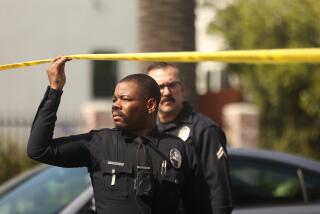Crips and Bloods Factions Prepare Ground for Widespread Gang Truce : Cease-fire: More than two dozen rival groups plan to raise funds to support legitimate businesses. The profits would go toward recreational centers, drug treatment and community facilities.
- Share via
Some of Los Angeles’ most notorious Crips and Bloods factions Wednesday announced a cease-fire among more than two dozen rival groups, laying the foundation for what could be the most far-reaching truce yet among the city’s black gangs.
In an emotional gathering at a Crenshaw district youth center, “shot-callers” who once would have shot at each other--in the name of the Rollin’ 60s, Eight-Tray Gangsters, Hoover Crips or Black P. Stones--arrived unarmed and exchanged embraces. Although their negotiations have been under way for nearly two months, they said they waited to reveal their efforts until they were sure that more than a decade of deadly violence had been halted.
“We’re black men--not gangsters or hooligans or thugs--but black men trying to take care of ourselves, our people, our women and our children,” said Lil Cat, 32, one of about half a dozen ex-gang leaders on the cease-fire’s coordinating council. “It’s time to say: ‘I love you, homeboy.’ It don’t matter where you from.” The cease-fire is designed to rekindle some of the momentum lost since the 1992 riots, when Bloods and Crips first exchanged vows of peace in Watts. That truce, still a unifying force among the community’s three largest housing-project gangs, never really caught on with most of Los Angeles County’s 300 other Crips and Bloods factions.
The current effort is rooted in what South-Central gang members generally consider the Westside--any turf between the Harbor Freeway and Inglewood. It is the domain of such infamous gangs as the Eight-Trays, which control the corner of Florence and Normandie; it is also home to their once-bitter enemies, the Rollin’ 60s, who were responsible for the fatal 1988 shooting of a Japanese American woman in Westwood, which opened the eyes of many middle-class residents to the horrors of gang violence.
“We started this mess,” said Big Ship, a 30-year-old former gang leader from Gardena. “Now we got to clean it up.”
Just as truce proponents in Watts tried to translate their efforts into economic development, the leaders of this cease-fire are forming a nonprofit corporation to stimulate legitimate business deals for former Bloods and Crips. They have dubbed themselves BEGIN TO, for Black Generations in Neutral Taking Off.
Under a preliminary business proposal, the gangs plan to raise $5,000 in at least 20 neighborhoods by holding dances and basketball games. Once they have amassed an investment pool of $100,000, they hope to spawn enough entrepreneurial ventures to fund recreational centers, arts-and-crafts fairs and drug-treatment facilities.
“What they’re basically saying is, ‘Give a man a fish and you’ll feed him for a day; teach him how to fish, and you’ll feed him for a lifetime,’ ” said Chilton Alphonse, whose Community Youth Sports and Arts Foundation has served as a neutral site for the negotiations.
“Any time people are willing to lay down their arms for a legitimate purpose, they should definitely be praised,” said Anthony Thomas, Mayor Richard Riordan’s liaison to South-Central, who has attended two of the sessions.
“As a native myself of South Los Angeles, I would like to assist anything that furthers the peace effort,” Thomas said.
Law enforcement authorities tend to view such truces with skepticism, noting that the cycle of retaliation sometimes ends up replaced by more financially rewarding mayhem. But Lt. Dennis Shirey, head of the Los Angeles Police Department’s anti-gang unit in South Los Angeles, said he welcomes any effort to save lives. Although he has yet to see evidence of gang-related crime dropping in truce neighborhoods, Shirey said, “If they’re successful and they can pull it off, it’s great.”
More to Read
Sign up for Essential California
The most important California stories and recommendations in your inbox every morning.
You may occasionally receive promotional content from the Los Angeles Times.













